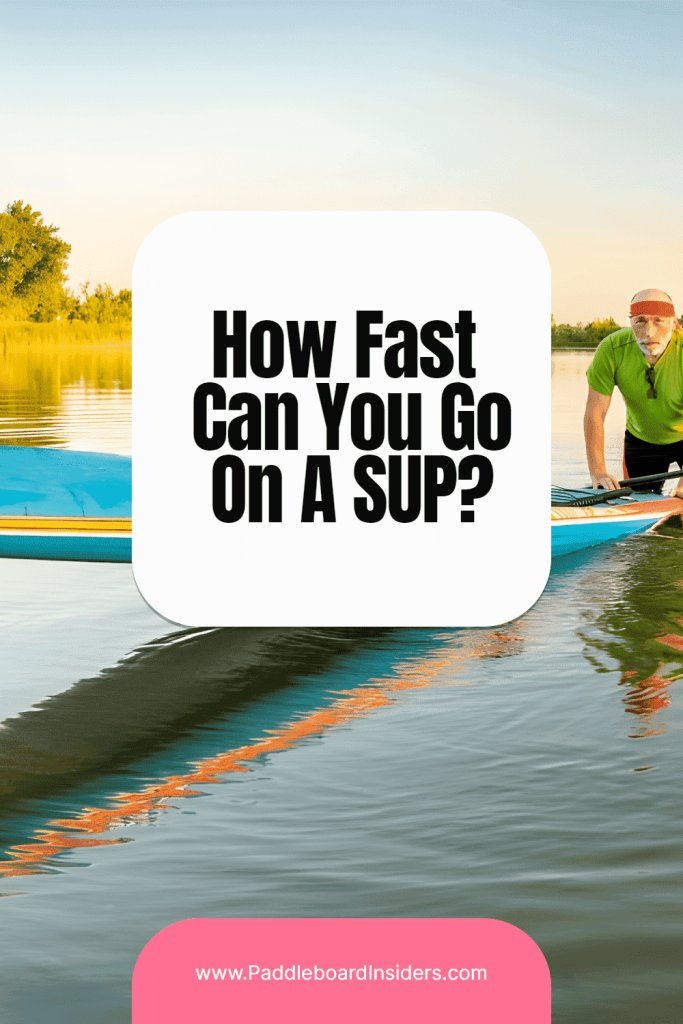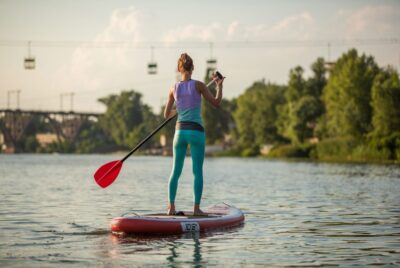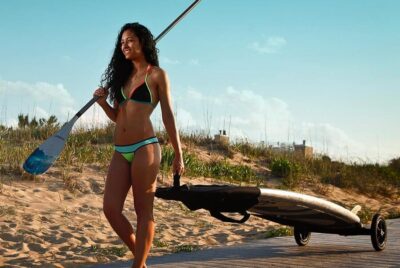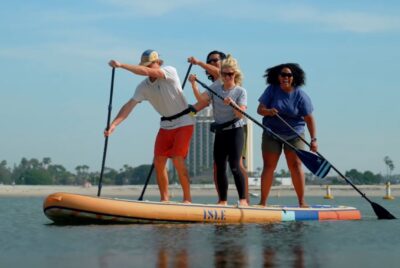How Fast Can You Go On A Stand Up Paddleboard?
*We may earn a commission for purchases made using our links. Please see our disclosure to learn more.
Wondering about your paddleboarding speed? We all have… It’s an amazing feeling to go from barely being able to stand on a SUP to a point where you’re wondering – “how fast can I actually go?”
That’s why – In this article I will be analyzing how fast you can go on a paddleboard, along with the different factors that influence speed, tips for choosing the right equipment, and techniques to propel yourself across the water with grace and velocity.
| Looking for our best paddle board product recommendations? Check the Paddleboard Insiders Buyer Guides |
Table Of Contents
- What’s The Paddleboarding Speed Of An Average Person?
- Factors Influencing Paddleboard Speed
- Choosing the Right Paddleboard for Speed
- What Board Should Go Get For Maximum Paddleboarding Speed?
- Paddleboarding Speed Boosting Accessories
- Paddleboarding Speed: Other Factors
- Training Tips for Increased Paddleboarding Speed
- Conclusion
- Paddleboarding Speed FAQs
What Are The Current Paddleboarding Speed Records?
The fastest paddleboarder in the world competition has been heating up lately…
Connor Baxter managed to sprint 200m in just 53:12 seconds, which is about 8.5mph (13.68 kmh) in 2016. To give you some context on how fast this really is, it’s about 38 meters per second.
And that’s only the fastest official speed. Danny Ching managed to set a world unofficial record of 46.60 seconds for a 200m race.
So that can give you some context on how fast the best paddlers are currently going on a paddleboard.
But that doesn’t really answer your question, does it?
What’s The Paddleboarding Speed Of An Average Person?
I remember the first time that I started paddleboarding and I saw how slow I was really going, but with a little training and the right equipment you can pick that speed up quickly.
Obviously the average speed of a person paddleboarding can vary depending on factors such as skill level, experience, and the type of paddleboarding activity.
Generally, beginners tend to paddle at an average speed of 2 to 4 miles per hour. As they gain experience and proficiency in paddling techniques, their speeds may increase…
For recreational paddling and leisurely exploration, many individuals maintain a comfortable pace of around 3 to 5 miles per hour.
On the other hand, more experienced paddleboarders, especially those engaging in racing or fitness paddling, can achieve speeds ranging from 5 to 10 miles per hour or even higher during sprint events.
Factors Influencing Paddleboard Speed
Here are some of the key factors that influence the speed you go on a SUP:
| Board Design and Length | The type of paddleboard you choose plays a pivotal role in determining your speed. Longer and narrower boards designed for racing generally offer greater speed compared to wider, more stable boards ideal for casual cruising. |
| Paddle Length and Material | Selecting the right paddle is as crucial as the board itself. The length and material of the paddle affect your efficiency in each stroke, impacting overall speed and endurance. |
| Rider’s Technique and Experience | Your skill level and technique are paramount. Even the fastest board won’t reach its full potential without a proficient paddler. We’ll delve into proper stances, posture, and paddling strokes to enhance your speed on the water. |
Choosing the Right Paddleboard for Speed
Touring vs. Racing Boards
Understanding the distinctions between touring and racing boards is essential. Each serves a specific purpose, and choosing the right one for your goals can significantly influence your speed and overall paddling experience.
You can see the different types of paddleboards below:
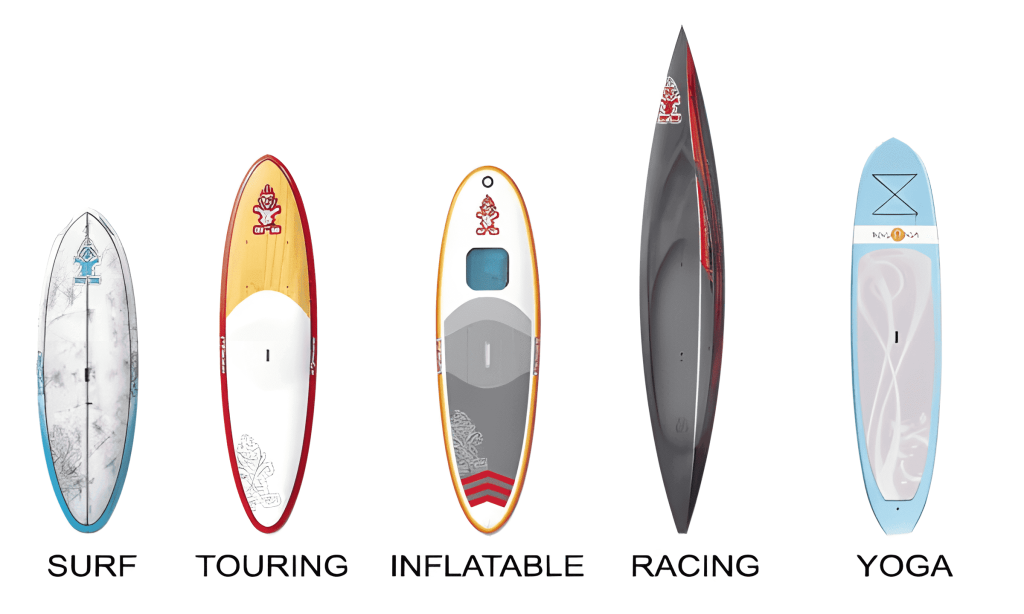
But I want to draw a key distinction between a racing paddleboard and a touring paddleboard.
Touring Paddleboard: Designed for exploration and long-distance paddling, touring boards are versatile and well-suited for various water conditions. They provide stability and ease of use, making them ideal for paddlers who want a relaxed experience on the water.
Racing Paddleboard: Specifically crafted for speed and agility, racing boards are built to perform in competitive environments. They are streamlined, narrower, and have a focus on minimizing drag to achieve maximum speed during races.
So you can see that a racing SUP is longer, thinner and has a pointed nose and tail to cut through the chop in the water. But the major factor that allows for paddleboarding speed is the hull shape.
Hull Shapes and Their Impact on Speed
The hull, or the bottom surface of the board, comes in various shapes, each designed for specific conditions and purposes. Let’s delve into the science behind hull shapes and how they contribute to the speed of your paddleboard, whether you’re navigating calm lakes or challenging ocean waves.
There are 3 major hull types that you should care about:
| Displacement Hull: | Displacement hulls are known for providing excellent straight-line tracking and speed in calm waters. They are often favored for touring paddleboards where speed and efficiency over long distances are priorities. |
| Planing Hull: | Planing hulls are advantageous in waves and rougher conditions, providing stability and ease of maneuvering. While they may sacrifice some speed compared to displacement hulls in calm waters, they excel in versatility. |
| Round Hull: | Round hulls offer a balanced approach, making them suitable for a variety of conditions. While they may not excel in extreme speed or extreme stability, they provide a versatile option for paddlers who want a bit of both. |
What Board Should Go Get For Maximum Paddleboarding Speed?
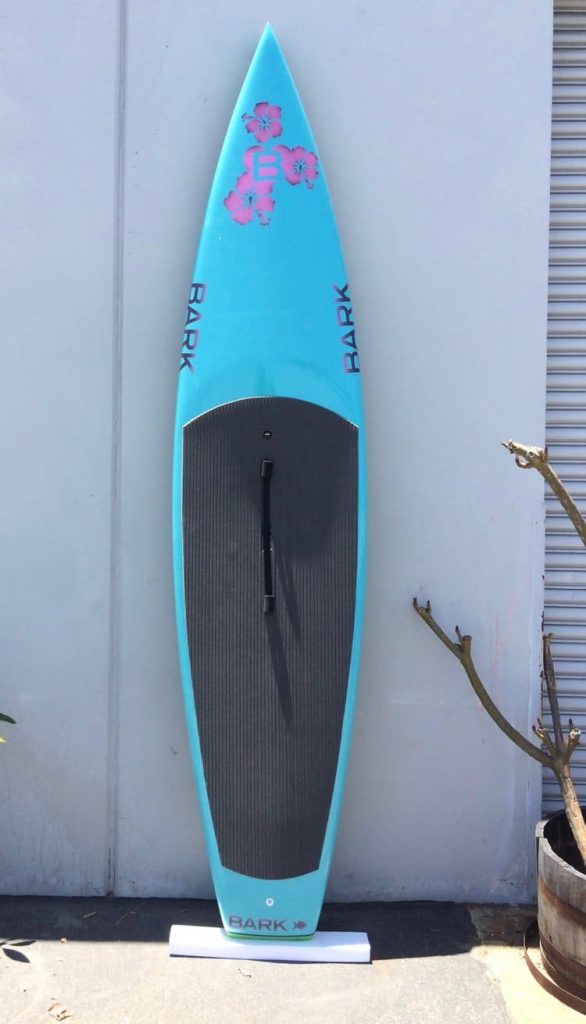
The big problem with the fastest paddleboards is that they are custom made.
That makes it difficult to give you a definitive answer, but if you are willing to get a custom paddleboard created for you then I would recommend that you look at Bark paddleboards.
They are some of the best prone racing paddleboards on the market right now.
But you’re going to have to be willing to pay a pretty sum of money because they are the best.
But if you just want to get your feet wet with a middle-range racing paddleboard that can get you from A-Z fast, then these are my recommendations:
| Category | Racing Paddleboard |
| Best Budget Racing Paddleboard | Wowsea Swift S1 |
| Fastest Prone Inflatable Paddleboard | Sea Gods Carta Marina |
| Highest Quality Racing Paddleboard | Tower iRace |
Board 1: Wowsea Swift S2 (Best Budget Racing Paddleboard)
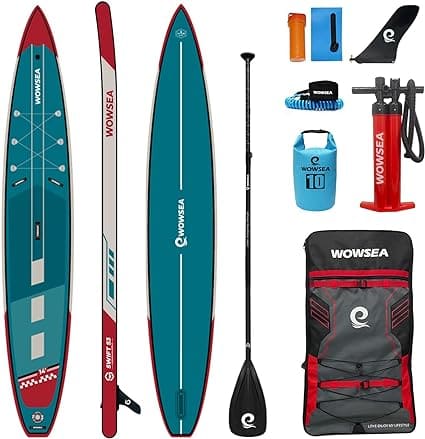
Where To Buy: Amazon
Key Features:
– Allows up to 263lbs in weight
– 14′ in size
– Comes with bag, leash, fin, backpack, waterproof bag and paddle
– 2 Year warranty
The Wowsea is an unsung hero when it comes to beginner paddleboards. It is a large board that will allow you to cut through the roughest waters on your pursuit of speed. It’s made of durable and high quality materials that will last you years if you look after it. And it’s surprising stable – It has a 6″ thickness that will provide you extra stability when inflated to 15PSI. It comes with a 2 year warranty and this is a beginner racing paddleboard that will make you extremely happy.
Board 2: Sea Gods Carta Marina (Fastest Prone Inflatable Paddleboard)
Where To Buy: Amazon
Key Features:
– Allows up to 285lbs in weight
– 12’32″ in size
– Comes with bag, leash, fin, wheelie backpack and paddle
– Lifetime warranty
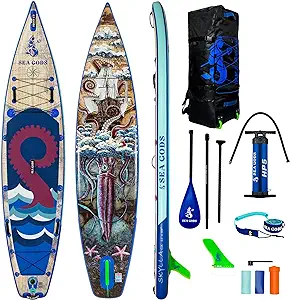
The Carta Marina stands out as an exceptional choice for racing or fitness paddleboarding. With its pointed nose specifically crafted to navigate choppy waters, this paddleboard excels in sea conditions and showcases an impressive speed capability. The single fin design strikes a perfect balance between speed and stability, making it ideal for racers. Beyond its performance, the Carta Marina boasts a visually stunning design, adding an aesthetic appeal that will be turning heads on the beach.
Board 3: Tower iRace (Highest Quality Racing Paddleboard)
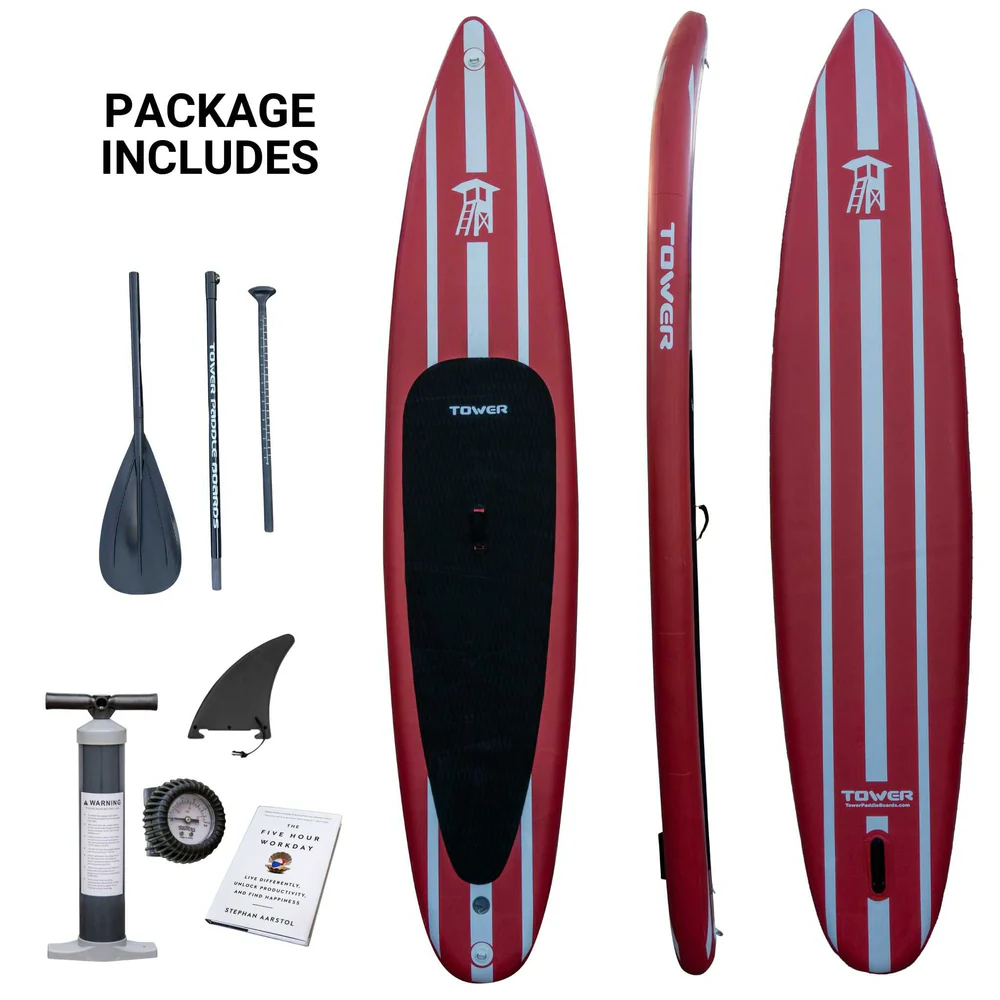
Where To Buy: Tower Paddleboards
Key Features:
– Allows up to 400lbs in weight
– 12’6″ in size
– Comes with paddle, pump, fin and book.
– 2 Year Warranty
The Tower iRace is a paddleboard that is designed for anyone that wants a crazy fast flat-water touring paddleboard. It is a really strong contender for top pick because it can easily act as a casual paddleboard that you can use anywhere. It is made up of top-quality materials that will last you forever (that’s why they give a 2 year warranty). It has a striking design and it extremely high quality. I love this board and I will always recommend Tower Paddleboarding because not only are they a great company, but they are also constantly pushing the boundaries of how to make a SUP exceptional.
So those are the boards that I would consider looking into if I was in your shoes.
But let’s talk about…
Optimal Paddling Technique
Here is a great video for you to watch about racing technique:
Paddleboarding Speed Boosting Accessories
Fins and Their Role
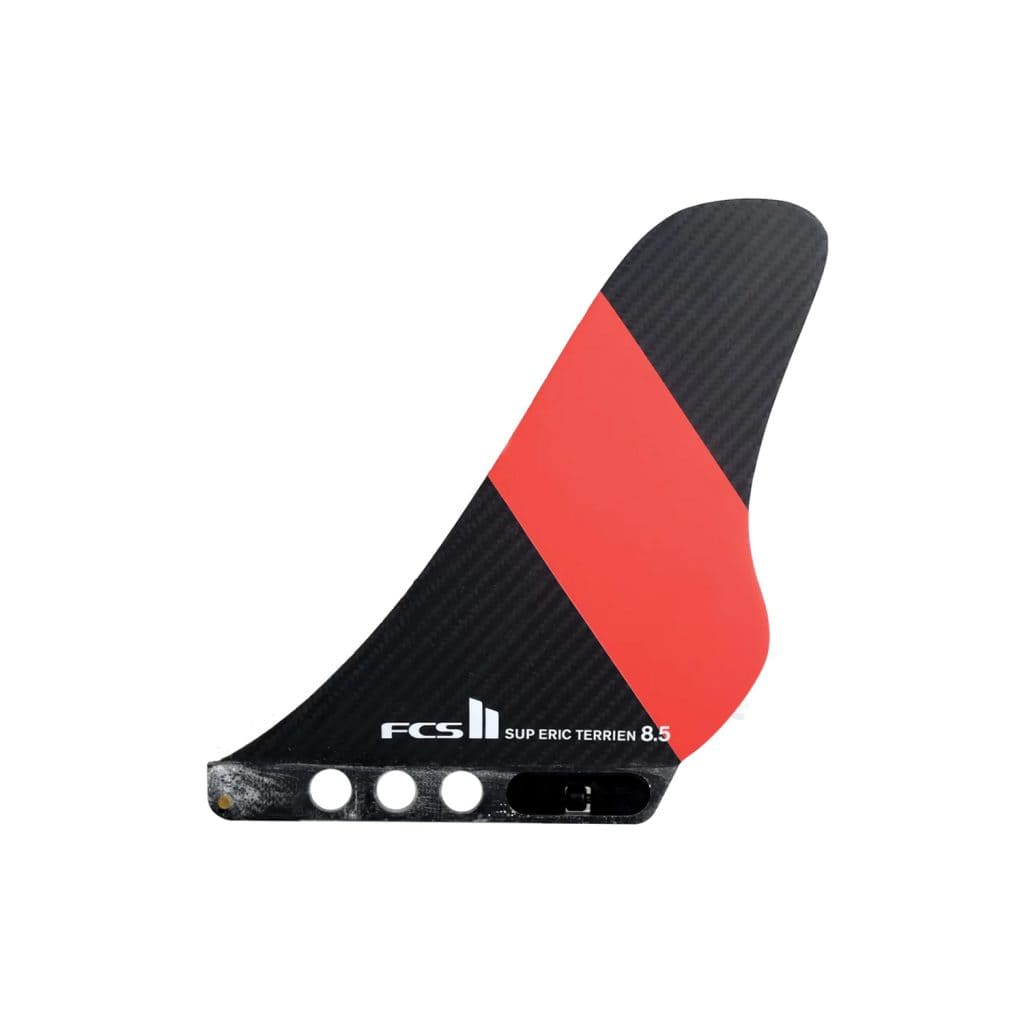
Race fins are really small and short because they want to offer as little resistance as possible to ensure speed. These fins are great for long races and touring board.
| For a more detailed analysis of different paddleboarding fins there read this article next: Choosing Paddleboard Fins Like a Pro: A Comprehensive Buyer’s Guide |
Leashes and Drag Reduction
When it comes to a racing leash you really want to get a coiled leash that won’t drag in the water or snag on things like rocks or seaweed.
My favorite leash is:
Leash 1: BPS Storm Ultralite Leash
Where To Buy: Amazon
Key Features:
– 10 Foot coiled leash
– Lightweight and durable
– 360 swivel system to prevent tangling
– 100% Guarantee
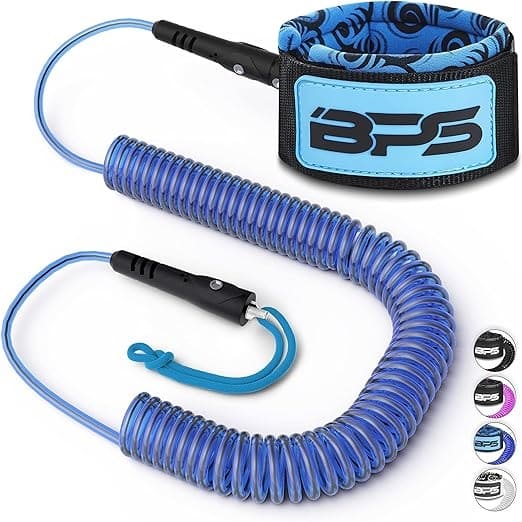
The BPS Storm is my most recommended leash. The reason why is because I absolutely love it! It’s a sturdy yet lightweight leash that I have owned for years. It’s coiled so it doesn’t snag on submerged rocks and objects, and it has a 10 foot range that gives you ample room away from your board if you need it.
| If you want more paddleboarding leash recommendations, then read this: 5 Best Paddleboard Leashes To Secure Your SUP In 2024 |
Next let’s talk about…
Paddleboarding Speed: Other Factors
Weather Conditions:
Weather plays a significant role in every aspect of paddleboarding, influencing not only your speed but also your overall experience on the water.
During a delightful sunny day, the primary source of propulsion is your own paddling effort. However, unless you’re an extremely skilled paddler, your speed might not be as impressive as on days with ideal weather conditions. In paddleboarding terminology, “downwinders” refer to paddlers who move with the wind at their backs. This strategic choice allows them to achieve higher speeds compared to paddling against the wind or dealing with challenging crosswinds.
In essence, weather conditions, particularly wind direction, can either enhance or hinder your paddleboarding adventure. Optimal conditions, such as sunny weather and favorable winds, can contribute to a more enjoyable and efficient paddling experience. Understanding how to work with the elements, like utilizing downwind paddling for increased speed, is key to navigating diverse weather scenarios effectively.

Fitness Levels:
It’s no surprise that your level of fitness directly impacts your paddleboarding performance. The fitter you are, the more power you can generate, leading to increased speed on your paddleboard.
For beginners or those gradually improving their fitness, the initial speeds may be modest. However, as you advance in the sport, honing both your fitness and paddling technique, you’ll notice a natural boost in your speed. The ability to paddle harder and glide smoothly through the water improves with enhanced fitness and refined technique, resulting in an automatic increase in speed.
During your early paddleboarding sessions, you might observe others effortlessly gliding past you. It’s important not to be discouraged by more experienced paddlers who appear to be moving at a faster pace. Keep in mind that everyone, even those now speeding along, started as beginners. Progress in paddleboarding takes time, and as your skills and fitness evolve, so too will your ability to propel your SUP at an impressive speed.
Training Tips for Increased Paddleboarding Speed
Here are some training tips that you can use to become faster on your paddleboard:
| Cardiovascular Fitness: | Engage in aerobic exercises such as running, cycling, or swimming to build cardiovascular endurance. This endurance is crucial for sustained paddling efforts during long-distance races or expeditions. |
| Paddleboard-Specific Training: | Incorporate high-intensity interval training (HIIT) sessions into your routine. This can involve paddling at maximum effort for short bursts followed by periods of active recovery. This approach simulates the intensity of racing conditions. |
| Core Strength Training: | Develop a strong core as it is central to stability and efficient paddling. Include exercises like planks, Russian twists, and leg raises in your routine. |
| Upper Body Strength Training: | Strengthen your arms, shoulders, and back with exercises such as push-ups, pull-ups, and shoulder presses. These muscle groups are heavily involved in paddleboard paddling. |
| Paddle Technique Practice: | Regularly practice paddleboard techniques on the water. Focus on efficient paddle strokes, torso rotation, and maintaining a proper paddling stance. Efficient technique reduces fatigue and enhances speed. |
| Cross-Training: | Incorporate diverse workouts into your routine. Cross-training activities like yoga, Pilates, or even surfing can complement your paddleboard training, enhancing overall fitness and agility. |
| Interval Paddling: | Incorporate short sprints during your paddleboarding sessions. Paddle at maximum effort for a designated distance, then recover at a slower pace. This mimics the demands of race scenarios. |
Conclusion
In conclusion, the speed potential of a paddleboard is a dynamic interplay of equipment, technique, and environmental factors. By understanding these elements and incorporating the tips and insights shared here, you’ll be well on your way to unlocking the full speed potential of your paddleboarding adventures. Embrace the thrill of the open water, push your limits, and let the gentle glide of the paddleboard become a swift dance with the waves.
| Looking for insider guides to some amazing paddle boarding locations? Check the Paddleboard Insiders Location Guides |
Paddleboarding Speed FAQs
How fast can a beginner realistically paddleboard?
Beginners typically paddle at an average speed of 2-4 miles per hour. As skills and confidence grow, speeds can increase, but starting at a moderate pace ensures stability and safety.
Do shorter boards sacrifice speed for maneuverability?
Yes, shorter boards are generally more maneuverable but may sacrifice some speed compared to longer boards. The trade-off depends on the paddler’s priorities and the type of paddling they intend to do.
What role do wind conditions play in paddleboard speed?
Wind significantly impacts paddleboard speed. Paddling against the wind can slow you down, while paddling with the wind provides a natural boost. Learning to navigate and use wind to your advantage is key for optimal speed.
Can paddling technique compensate for a lack of physical strength?
Yes, efficient paddling technique is crucial for speed and can compensate for a lack of brute strength. Proper form minimizes resistance, making it easier to maintain speed over longer distances.
Are there any safety concerns specific to high-speed paddleboarding?
Yes, high-speed paddleboarding comes with increased risks. Safety measures include wearing a Personal Flotation Device (PFD), being aware of surroundings, and knowing emergency procedures. Always prioritize safety, especially at higher speeds.
| Here are the best paddleboarding life jackets on the market right now: The 8 Best Paddleboarding Life Jackets Of 2023 |
